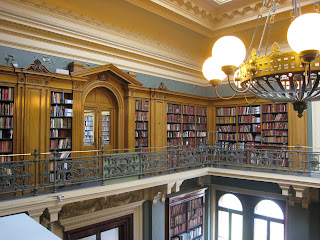 The Scottish Poetry Library is just a twenty-minute walk down the street from the other libraries/archives we visited in Edinburgh (Edinburgh feels so small compared to London!), and I am so glad that a few of us decided to check it out. Even though I've written poetry, I do not consider myself a poet like quite a few of my friends in creative writing. I knew that they would absolutely love to have a resource (and beautiful space) like this nearby. I definitely appreciated seeing the space, and knowing what a wonderful resource it must be for poets and poetry lovers.
The Scottish Poetry Library is just a twenty-minute walk down the street from the other libraries/archives we visited in Edinburgh (Edinburgh feels so small compared to London!), and I am so glad that a few of us decided to check it out. Even though I've written poetry, I do not consider myself a poet like quite a few of my friends in creative writing. I knew that they would absolutely love to have a resource (and beautiful space) like this nearby. I definitely appreciated seeing the space, and knowing what a wonderful resource it must be for poets and poetry lovers.Unfortunately, my camera died just as I managed to snap this lone picture, but I wanted to make sure I captured the natural light that cascades through the entire library, as well as show the bits of poetry that are written on the walls in a red font.
 The library was founded in 1984, with the building financed by the Scottish Arts Council National Lottery Fund. However, the library is a registered charity, and welcomes support from Friends. It is free for anyone to use. The collection's focus is contemporary Scottish poetry (written in English, Scots, and Gaelic); however, the collection also contains historic Scottish poetry, contemporary international poetry, poetry for children, audio and video, magazines, and collections for the visually impaired. The library also houses a wealth of published works by Scottish poet Edwin Morgan, who was the first poet laureate of Glasgow.
The library was founded in 1984, with the building financed by the Scottish Arts Council National Lottery Fund. However, the library is a registered charity, and welcomes support from Friends. It is free for anyone to use. The collection's focus is contemporary Scottish poetry (written in English, Scots, and Gaelic); however, the collection also contains historic Scottish poetry, contemporary international poetry, poetry for children, audio and video, magazines, and collections for the visually impaired. The library also houses a wealth of published works by Scottish poet Edwin Morgan, who was the first poet laureate of Glasgow.The Scottish Poetry Library is a lending library, and I was surprised to learn that you can also have materials mailed to you for 50p each. You can even borrow materials through interlibrary loan. I doubt they ship or send materials ILL to America, but the Scottish people are so nice, I wouldn't be surprised if they did!
I noticed that there in addition to services for poets and readers, there is a "for librarians" page on the website. One of the more exciting opportunities is a "Poetry in the Branches" class that librarians can take to promote poetry in their libraries. They also go into detail about their catalogue, indexing, and collection policy, and offer an e-newsletter specifically for librarians. This library seems to understand the importance of collaboration with other libraries, even though it is not a traditional public library. It also seems to know exactly what its poets and other readers need in a collection and a space, as poets have a number of resources available to help them flourish (and even publish), including a School of Poets group that meets monthly in the library. They also hosts all kinds of reading events and reading groups every month, each of which is completely unique, and therefore appeal to a wider audience. My favourite part is the poetry artwork all over the building - it is beautiful, inviting, and thought-provoking. If I lived in Edinburgh (it's still possible!), I would definitely take advantage of all the resources this library has to offer its community.
For more information about the Scottish Poetry Library, visit:
http://www.spl.org.uk
First photo courtesy of Dr. Teresa Welsh

















































